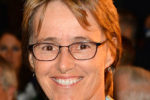The Extraordinary 2018 Eruption of Kīlauea Volcano, Hawaii
In the annual Roslyn Silver ’27 Science Lecture, Tina Neal will describe last summer’s intense volcanic unrest and eruption at one of the most active volcanoes in the world, and the highest-threat volcano in the United States, Kīlauea Volcano on the Island of Hawaii. Historically unprecedented rates of lava effusion destroyed hundreds of structures while 40 km away at the volcano’s summit, damaging earthquakes continued for months as the summit progressively collapsed before scientist’s astonished eyes. Neal will share highlights of the science behind the volcanic event and the complex incident response, a multi-agency effort to keep people safe.
About the Speaker
 A New Englander by birth, after college and graduate school, Tina Neal has lived primarily in the American west. Neal holds an Sc.B in Geological Sciences from Brown University (1980), an MS in Geological Sciences from Arizona State University (1986), and completed additional graduate study in Geology at UC Santa Barbara (1987-89).
A New Englander by birth, after college and graduate school, Tina Neal has lived primarily in the American west. Neal holds an Sc.B in Geological Sciences from Brown University (1980), an MS in Geological Sciences from Arizona State University (1986), and completed additional graduate study in Geology at UC Santa Barbara (1987-89).
Her earliest geology work was in planetary science looking at volcanoes on Mars as a NASA intern at the USGS in Flagstaff in 1980. From 1983-89, she worked for the US Geological Survey at the Hawaiian Volcano Observatory on the Big Island of Hawaii. She was part of the team tracking the 1983 – present east rift eruption of Kilauea and the 1984 eruption of Mauna Loa. She led geologic mapping of the southwest rift zone and summit areas of Kīlauea as part of the Big Island mapping project. She also participated in an ALVIN expedition to study a propagating submarine rift system on the ocean floor north of the Galapagos Islands.
In 1990, she moved to Anchorage to the newly established USGS Alaska Volcano Observatory. There, she worked on eruptions in the Aleutian arc, including the 1989-90 and 2009 eruptions of Mt. Redoubt, the 1992 eruption of Mt. Spurr, the 2005-6 eruption of Augustine, and the 2008 eruption of Okmok. During quiet times, she investigated the eruption history and volcano hazards of several young volcanoes on the Alaska Peninsula and the eastern Aleutians including two young calderas: Aniakchak (on the Alaska Peninsula) and Okmok (on Umnak Island).
In 1998, she took a 2-year temporary position as a USGS geoscience advisor to the Office of US Foreign Disaster Assistance of the US Agency of International Development in Washington DC. There, she was tasked with overseeing and initiating programs in geohazards mitigation, advising the office on responses to geologic disasters, acting as a liaison with other federal agencies and academics and NGOs working on natural hazard mitigation, and assisting the office in developing a global strategy to deal with natural hazards. She was fortunate in this assignment to travel to many countries, among them Thailand, Nepal, Ecuador, Colombia, and Kazakhstan where she reviewed or worked on implementation of hazard mitigation programs.
Neal returned to Alaska in June 2000, to resume duties as a staff geologist at the Alaska Volcano Observatory where she continued geologic mapping, eruption response, and physical volcanology studies of active Alaskan volcanoes. She focused on strengthening the Alaska-based interagency response system for volcanic eruptions with particular emphasis on reducing volcanic risk to aviation in the North Pacific. In summer 2014, she participated in an NSF funded multi-disciplinary study of the Islands of Four Mountains in the Aleutians. Working from a ship with a small helicopter, they managed to install the first volcano monitoring equipment on long-active, remote Cleveland volcano. From 2000-2015, she led coordination of AVO’s eruption monitoring and crisis response work with Russian volcanology counterparts in Petropavlovsk-Kamchatsky and Yuzhno-Sakhalinksk. In 2009-2010 she completed two details to the USGS Western Regional Office as Chief of Staff and Deputy Regional Director.
In 2015, Neal had the great honor to return to Hawai‘i as the Scientist in Charge of the Hawaiian Volcano Observatory. In addition to leading the Observatory during the 2018 eruption and summit collapse crisis, she has focused on workforce development and preparing for the next Mauna Loa eruption.
Image Credit: “Days, Weeks, Years? Scientists Say Hawaii Volcano Eruption Has No End In Sight,” NPR, 8/8/2018: https://www.npr.org/sections/thetwo-way/2018/05/08/609503580/days-weeks-years-scientists-say-hawaiis-erupting-volcano-has-no-end-in-sight
Registration information
Registration is preferred but not required. Registration will be open through the day of the event.
Please consider making a contribution with your registration. Your support makes our programming possible. No one will be turned away for lack of funds.
Accessibility information
The venue is accessible to people with mobility disabilities. Please contact BCRW for additional access needs.